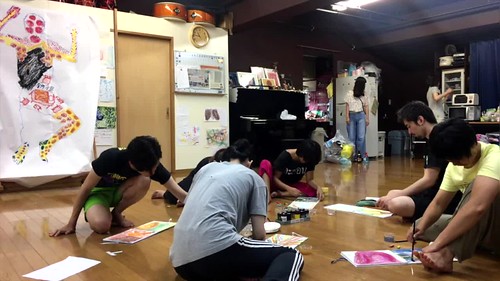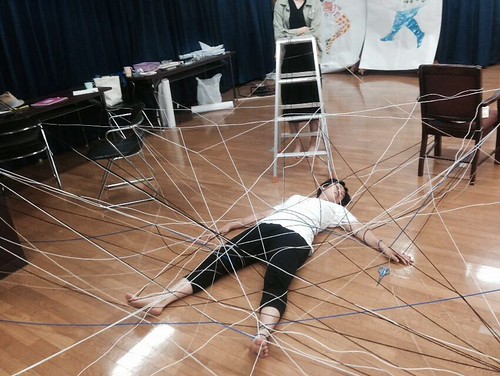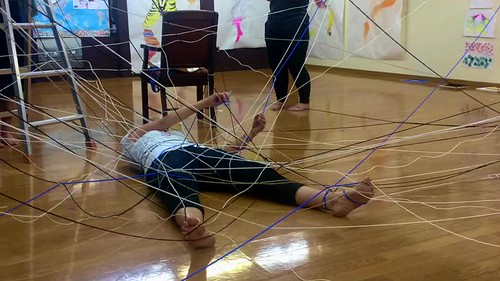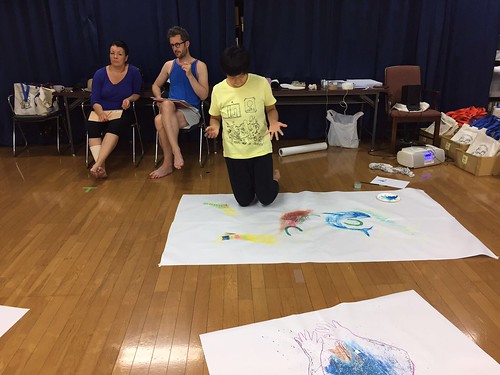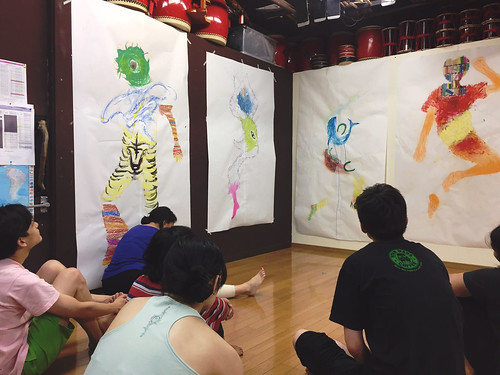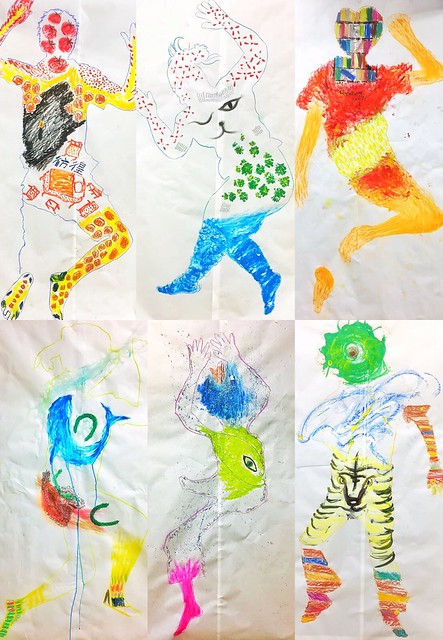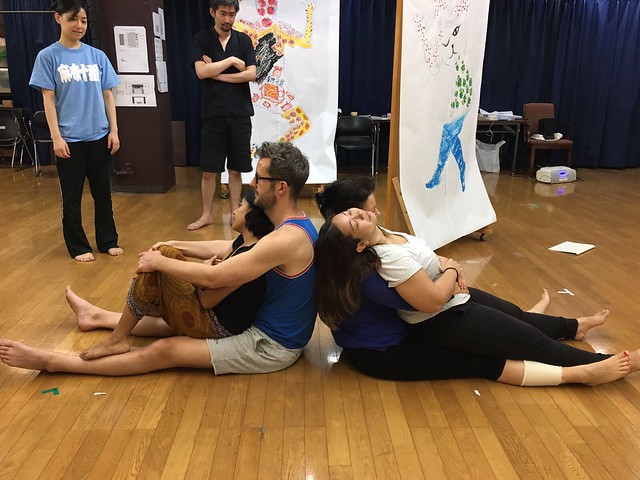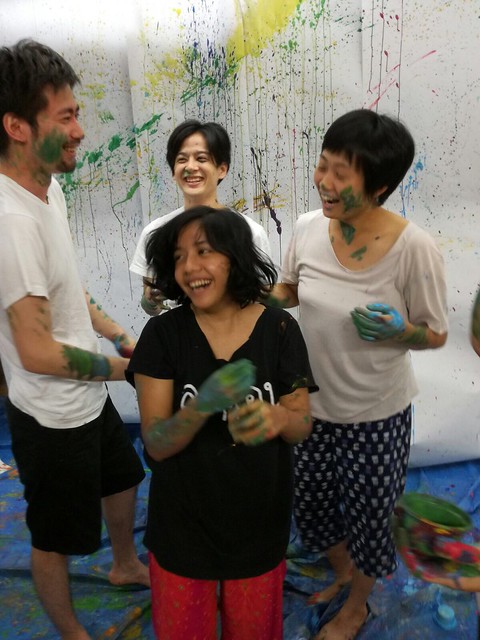Workshop Diary Part 2: Notes from ricca ricca*festa 2017
Published by Nessa Roque,
Last July, I went to Okinawa for a creation workshop program. This three-part series is me wrapping my head around those two weeks. Be warned: it’s a long post. I discuss the process of the workshop, overshare some travel stuff, and put in all the sharable media (photos and videos) we’ve gathered. Yes, yes!
Go to Part 1: Introduction to the Program
Go to Part 3: postscript: messy ramblings
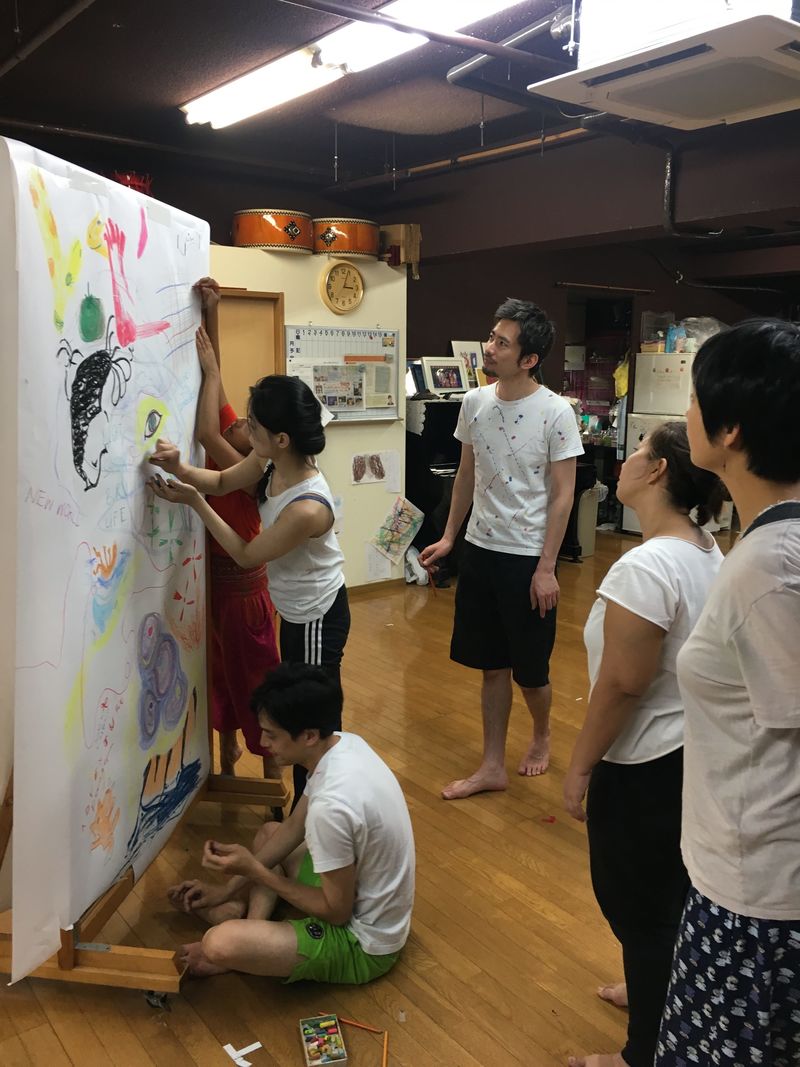
WORKSHOP 1
CREATING A NON-VERBAL PERFORMANCE FOR YOUNGER CHILDREN
Process: Visual Journalling
We began each day with a daily ritual of visual journalling.
For the first day we drew journals related to anything that happened upon arriving in Okinawa. However, for the following days Gill and Rob asked us to try and limit our journals to thoughts, images, emotions, and insights within the workshop itself. This proved to be an effective way to build on one another’s ideas as we continuously reframe, retell, and add to each other’s stories and thoughts about the workshop. It was a different way of facilitating a sustained dialogue about everything that was happening within the workshop.
After drawing / painting on our own for 30 minutes, we would sit in a circle to discuss each piece. First we would show our work and ask others what they see in it. Naturally, people would have different readings and interpretations of the image. Mostly these could be abstract thoughts or feelings that they get from the work. Some would make up stories. And as the days went by some would recognize the activities or specific points from the workshop that the journal entry refers to.
What fascinated me was how Gill and Rob would suddenly devise something from these visual journals. For example, Ladda made this drawing of a baby and it looked like it’s very very safe and comfortable. After she explained her drawing, Gill asked everyone to stand in a circle, with Ladda in the middle. She then says, (in her lovely Scottish accent), “We are all Ladda’s mum, without saying anything, how can we make her feel safe and comfortable?" We then spend a few minutes improvising, guided by this prompt. We touched, hugged, caressed, and led Ladda into our collective care as her mother. These exercises led to very strong and moving moments.
I admire how intuitively Gill and Rob would find these moments that we could move into/physicalize beyond the drawings. They were also very good at thinking of parameters for these improvisations.
So the workshop went on like this, from our images and stories, Gill and Rob would pick up something and we’ll try to physicalize, or move using the images as prompts. Generally each day would be divided between building content and devises based on the drawings and movement exercises for actors like contact improvisation and viewpoints.
Process: Self Portraits
Aside from the daily visual journals, a major visual activity we did was creating self portraits.
We started by working with a partner. We took turns, striking a pose on a huge piece of paper on the floor while the other one would draw the outline of this pose.
We then filled the rest of our own outlines by answering these questions: What furniture, animal, element, vegetable, and piece of text, are you?
We were free to fill the outline and answer the questions however we wanted to. The drawing / painting didn’t have to be perfect, it’s just about answering the questions truthfully (and having fun, of course).
Similar to how we discussed our daily journals, we first showed our portraits to the group and asked others to say what they see in it. We interpret each other's works and make up our own stories and ideas. Finally, the person who drew the portrait explains her/his work.
Eventually, this whole self portrait exercise became a central element to the workshop. The characters, images, and stories that we made—both the ones we interpreted when looking at one another’s work and the actual answers we had in mind—fireworks, beds, kimonos, fire, string, fox, tiger, mermaid, etc.—were later used in the workshop and the performance showcase.
* Slideshow (click on the right side of the photo to see more):
*Photos by Keita Hara
Again, as we explained what we drew and shared what we saw in the portraits, Gill and Rob would jot down phrases and sentences, which they later used as prompts for improvisation and devising exercises.
For example, at one point one person said this about one of the drawings: “the tiger is holding the storm inside her." A few days later, when we did tableau exercises, one of Gil's prompts was to create a tableau of “the tiger is holding the storm inside her."
The prompt for this one was, “her pink foot entered a new world"
Again, this goes back to the central element of continuously building on what we initially shared by re-interpreting or redoing the images either by creating our own drawings, stories, or by physicalizing them.
* Slideshow (click on the right side of the photo to see more):
Creating Ladda’s human sofa
As the days progressed, we slowly began building a general thread of images and characters based on the drawings and the exercises.
Process: Theater and Devising Exercises
Aside from the exercises based on drawings and paintings, we also did a lot of work to strengthen the actors as individuals and as a group—we played theater games, games from our childhood, contact improvisation, a lot of group massage, listening/sensitivity exercises like two people alternately leading each other using a very thin thread (it was soooo hard), viewpoints, exploring and composing experiences of spaces and directing audience participation.
One exercise was to choose spaces within the workshop that corresponded to the following: a space to hide, a space to watch, a space to feel powerful, etc.
We then partnered up and shared our spaces with our partner, without speaking. It was up to us how we would lead them into the spaces and how we would let the person experience these spaces. After sharing with the partner, we chose just one space which we would share to the whole group.
We were given a bit of time to modify / add elements to the spaces we chose to amplify the feeling / intention of that space. We also had to devise how we would transition from one person’s space to another, or if people would experience the places one by one, in groups, or altogether. It was already an exercise on directing—composition of time and space and audience experience.
Process: Drawings x Improvisation = Devising Performance
Recurring themes based on the drawings and journals were the ideas or feelings of safety, comfort, and adventure (articulated and re-articulated as we built more and more conversations and images around these ideas).
One exercise we did was to have one ‘leader’ (Ladda) who, without speaking, guides everyone what to do. What was interesting was how they did not just copy one another, they were ‘following’ Ladda’s instructions in their own ways, they were playing together, not copying each other.
(Note: I wasn’t part of this exercise because I had a concussion from falling head first the day before and I was very groggy. I was in a corner sleeping what was perhaps the deepest sleep of my life, LOL. When I woke up, I was feeling totally fine and normal again, and I had the greatest pleasure of watching my fellow actors do the exercise.)
The next prompt was for Ladda to guide everyone just by using her eyes. This proved to be very difficult, but the group managed. At this point, ‘Ladda’ seemed to become a mother figure, while the rest of the group behaved very much like siblings. The next prompt was for Ladda to leave them and they will have to figure out what to do now that she was gone. We were surprised at how strongly Ladda’s absence was felt by the group. Without a leader guiding the ‘siblings’ they were at a loss on how to move as a group or just what to do next.
This eventually played out into a lovely scene where the ‘siblings' started playing together, teaching each other little tricks and they also started having funny little fights. The next prompt was that they could start speaking this one sound, which was, “Ladda." I can’t remember when but at some point Ladda, who was now sitting next to me in the audience, started crying. One of the actors, Atsuto, emerges as a ‘youngest sibling’ character who felt Ladda’s absence the strongest and needed much help from the rest of the group.
Gill adds another prompt. She places a blue string that leads to the door. It was up to the siblings if they wanted to follow this string into a new world of adventure. However, leaving the space meant they will never see Ladda again. This was another beautiful moment of improvisation where the siblings—who now have a clearer relationship with each other and have developed a sense of individual character and temperament—reacted to the string. As the playful and mischievous sibling, Keita, touches the string with his feet and everyone screams in surprise and panic. He laughs it off and tests the string even further. It was clear that he was going to follow the string and he’s convincing his siblings to join him. The bold and curious one, Yuria, immediately follows him. The vulnerable youngest sibling, Atsuto, is now panicking as he sees them slowly approaching the door. One other sibling, Lindy, comforts him and slowly convinces him that it was safe to follow the string.
Eventually, at their own pace, everybody got through the door.
This basic narrative eventually became the nucleus of the performance showcase.
This exercise also led to the discovery of the ‘pillow man’ character, similar to a child that badly needed his mom and her protection. We also did another exercise where Atsuto, wrapped in a pillow armor, had to say goodbye to Ladda and he had to figure out how he was going to remove the pillows that is keeping him safe but is also hindering his movement.
In the following days we did exercises exploring these themes and images.
The performance showcase was an attempt to piece together the images and characters we collectively found and created during the workshop — using shadowplay and paint to create fireworks, the human sofa, playing together as weird creatures that act like siblings, the pillow man, etc.
Process: Exploration
The key element of the creation workshop was to explore and play. I appreciate that some exercises didn’t work. One example would be this whole afternoon of exploring Japanese garments (kimonos, yukatas, and hakamas) as objects (please let me know if I’m using the terms wrong, I did a bit of research and I seem to recall that these were the garments we used 😃).
Gill and Rob were joking that the exercise was a failure haha. In the end we abandoned using the kimonos, yukatas, and hakamans for the show. In a way, though, it wasn’t a failure because we still learned a lot in that exercise. It pushed our imagination, stamina, and control as we moved the kimonos together for a looooong time. We also learned a lot about our cultures as the Japanese actors expressed how their different attitudes towards the value of the garments really informed the way they moved and reacted to the fabric. I, too, felt guilty at the end, knowing that during the exercise, as a foreigner, I embraced the fact that the garments did not have any particular weight or meaning to me, so I didn’t really respect them as objects.
Anyway, it was valuable to see Gill and Rob really allow time for exploring and failing, even though we only had very limited time before the showcase. The point was to test if something works or not and the performance was not calculated beforehand.
We know that the process, the prompts, and the exercises themselves were planned and carefully thought through by the director and the playwright, but there was a lot of space for collaborative creation between all the artists.
Gill and Rob also did a good job in creating the structure of the showcase. They were the ones who were looking at the performance on a macro level, which allowed the actors to explore on a micro level. As actors, we knew that we were in safe hands and that all the exploration that we were doing was going to be structured later on by Gill and Rob.
SHOWCASE
In the end, Gill and Rob decided that the showcase should be improvised but with determined plot points/scenes. The intention was to share interesting images and moments that we found during the workshop.
We were well aware that it didn’t have a clear narrative yet, and it was more impressionistic and image-based. Perhaps, it wasn’t even a performance yet, but a showcase of the workshop and a peek into how the group worked together to create something out of nothing in two weeks, and shows our potential of creating a unique performance if given a chance to work together again.
It was a really creative and refreshing experience for me. After years of devising performances, I was glad to become part of another way of working and creating a piece. It opened my mind to other possibilities of collaborative processes.
The workshop and the performance showcase we did kind of had a primal element to it. We did feel like children, but of course we are still burdened by our histories as adults so we were also tapping into our own fears as we created these autobiographical images and stories. However, I feel that if we move the process forward we will eventually be able to distill the work and arrive at primal emotions and key ideas that specifically speak to the experience of children.
(Check out a review of the showcase here: Playing with Language and Music by Caleb Lee)
Notes on International Collaboration
This has already been a really long post but I still probably have more to say, only because I’ve learned so much. Perhaps a key learning I could articulate now is how using images and movement was particularly effective in an international collaboration.
The most important moments in the workshop were not anchored by words but by drawings on paper and the moving body in space. This lessened the burden of translation because we had other ways of communicating with each other. Due to the painful colonial history of my country, I speak English very well, but the ‘conversations’ I remember most from the workshop and showcase were all unspoken—the brightest orange on a huge piece of paper, a mother’s long embrace, the shadow of a baby tiger seeing light for the first time, sitting together as human sofas, silently guiding each other with our eyes, throwing paint as fireworks, and a lot of silly dancing.
To me, this serves as a provocation as we create a “Non-Verbal Performance for Younger Audiences that can be performed anywhere in world." Through the workshop, I have personally experienced the power of communicating beyond words and language. The next question is how to translate it into a powerful performance for younger audiences.
Go to Part 3


